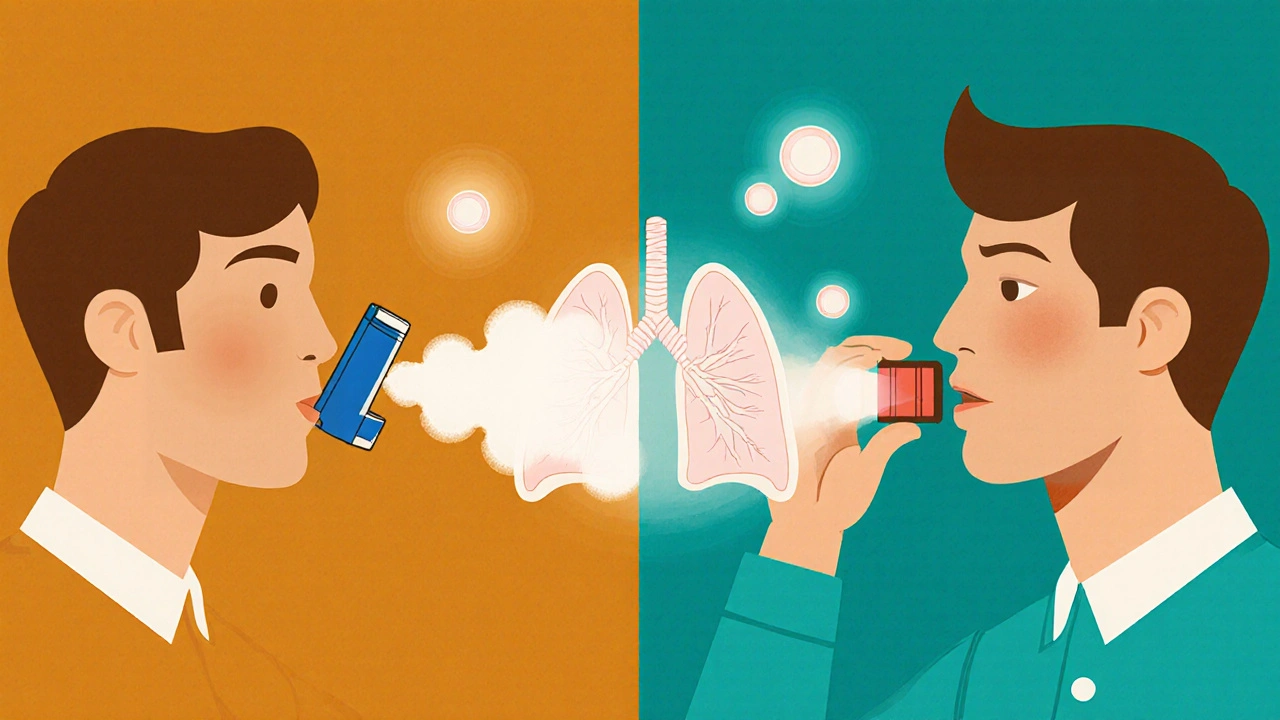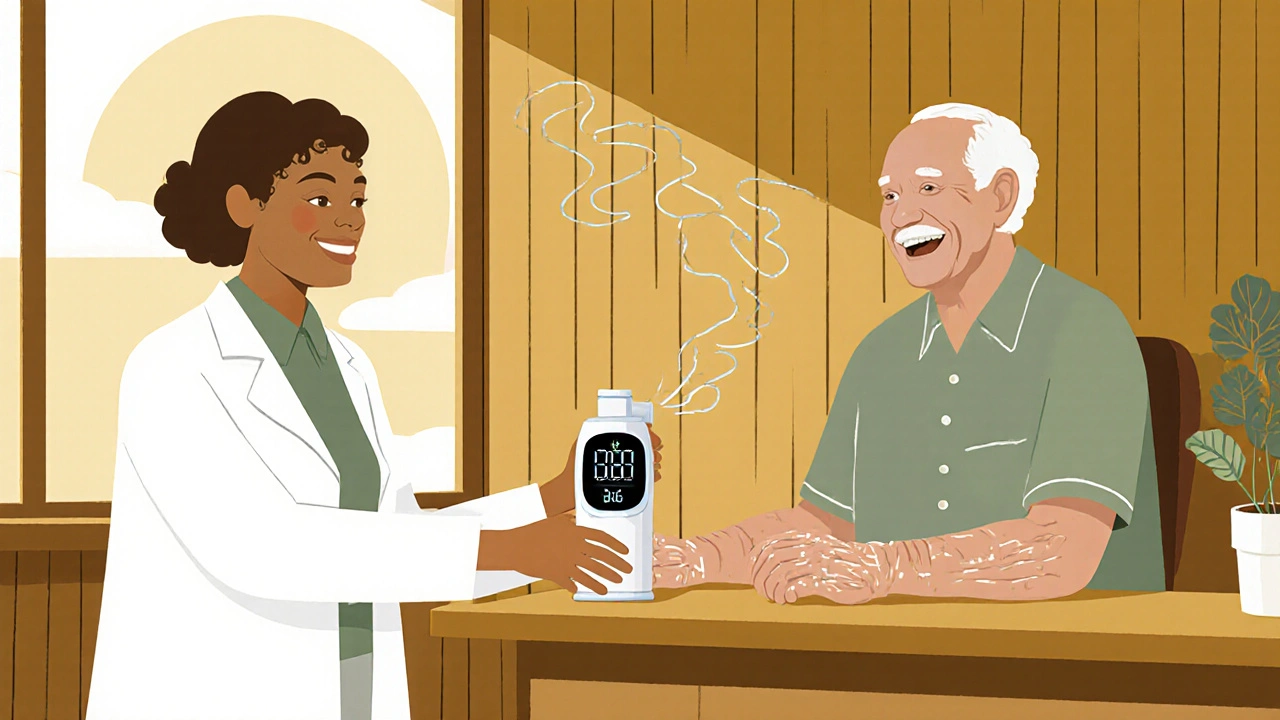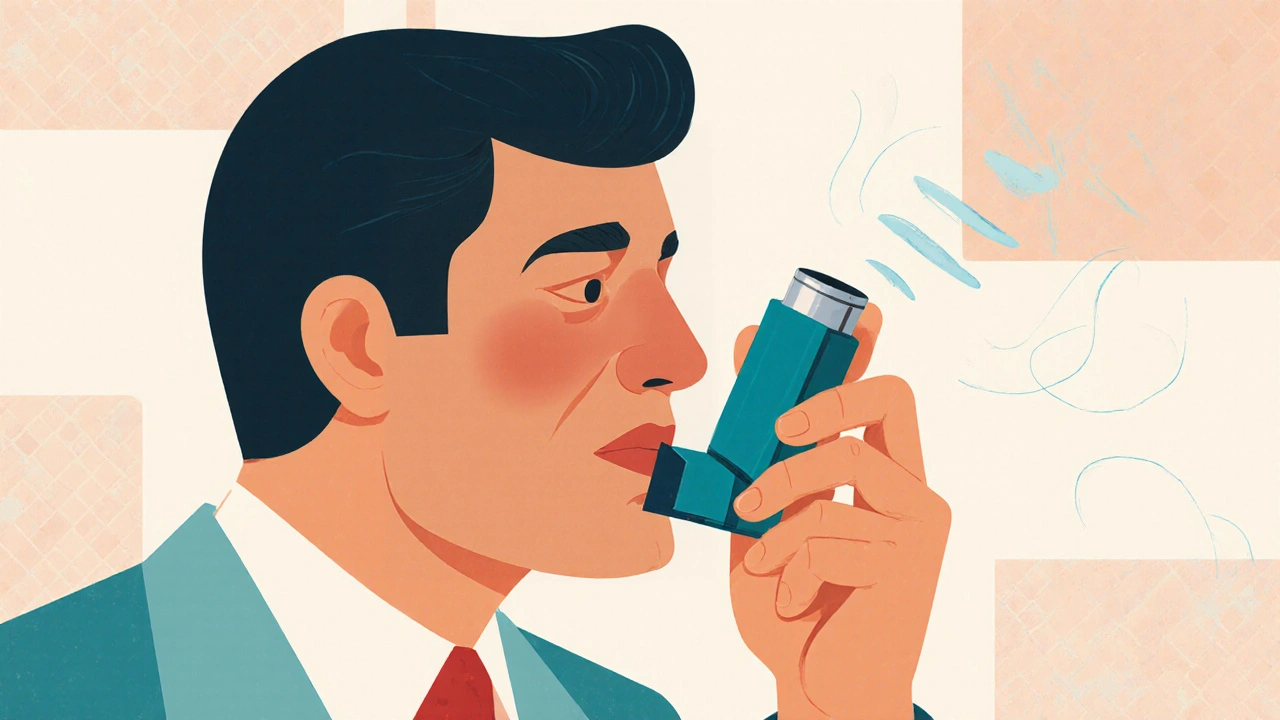Most people with asthma or COPD rely on inhalers to control their symptoms. But here’s the harsh truth: if you’re not using your inhaler correctly, you might as well be spraying medicine into the air. Studies show that 70 to 90% of people use their inhalers wrong. That means only 10 to 20% of the drug actually reaches your lungs. The rest sticks to your mouth and throat - causing side effects like oral thrush, wasting medication, and leaving your symptoms uncontrolled.
Why Your Inhaler Isn’t Working
Metered-dose inhalers (MDIs) are designed to deliver a precise puff of medicine deep into your lungs. But that only happens if you time your breath right. The medicine comes out in tiny droplets - 50 to 150 microns wide - and needs to be inhaled slowly at about 30 liters per minute. If you breathe too fast, the particles crash into the back of your throat. If you press the inhaler too early or too late, most of the dose never makes it past your mouth.And it’s not just timing. Many people skip the most important steps: shaking the inhaler, exhaling fully before inhaling, holding their breath after the puff, and rinsing their mouth afterward. Even small mistakes add up. A 2022 study found that patients who used their inhalers correctly had 45% fewer asthma attacks than those who didn’t.
Step-by-Step: How to Use a Metered-Dose Inhaler Correctly
Follow these eight steps every time you use your MDI. Do them slowly. Rushing is the enemy of proper delivery.
- Remove the cap and check for anything blocking the mouthpiece. If you see powder or debris, wipe it gently with a dry cloth.
- Shake the inhaler for 5 to 10 seconds. Most HFA inhalers - like ProAir HFA, Flovent HFA, and Ventolin HFA - need this to mix the medicine and propellant. Skip this step, and you might get a weak or uneven dose. (Note: Alvesco and QVAR don’t need shaking - always check your label.)
- Breathe out completely - as far as you can. Don’t just exhale a little. Empty your lungs fully. This creates space for the medicine to go deep.
- Place the mouthpiece between your teeth and seal your lips tightly around it. No gaps. No holding it an inch away from your mouth. This is different from old CFC inhalers. With modern HFA devices, you need a tight seal.
- Start breathing in slowly - just before or at the exact moment you press down on the inhaler. This is the hardest part. Many people press the inhaler first, then try to breathe in. That’s too late. The medicine is already gone. You need to begin inhaling slowly over 3 to 5 seconds while pressing the canister.
- Hold your breath for 10 seconds after inhaling. This gives the medicine time to settle in your airways. If you exhale right away, most of it just leaves with your breath. Studies show holding your breath increases lung delivery by 30%.
- Breathe out slowly through your nose. Don’t cough or blow hard. Let the medicine stay where it landed.
- Rinse your mouth with water and spit it out. This is especially important if you’re using a steroid inhaler like Flovent or Advair. It cuts your risk of oral thrush by 40%.
What Happens When You Get It Wrong
Most people think their inhaler isn’t working because the medicine “doesn’t feel like it’s doing anything.” But the real problem is where the medicine ends up.
When technique is off, 80% of the dose lands in your mouth and throat. That’s why you get a bad taste, sore throat, or white patches (oral candidiasis). It’s also why your symptoms don’t improve - the medicine isn’t reaching the lungs where it’s needed.
Doctors see this all the time. Patients come in saying their inhaler “doesn’t help,” but when they’re watched using it, they’re pressing the inhaler after they’ve already started breathing in. Or they’re not shaking it. Or they’re holding their breath for only 2 seconds. These aren’t just small errors - they’re treatment failures.

Spacers: The Secret Weapon for Better Delivery
If you struggle with timing, you’re not alone. Coordinating the puff with your breath is hard - especially for kids, older adults, or anyone with shaky hands. That’s where spacers (also called holding chambers) come in.
A spacer is a plastic tube you attach to your inhaler. You spray the medicine into the spacer first, then breathe in slowly through your mouth. It removes the need for perfect timing. Your lungs get 70 to 80% of the dose instead of 10 to 20%.
Parents report that using a spacer with a mask makes it easier to treat young children. Older adults with arthritis find spacers easier to handle than holding the inhaler directly. And studies show people using spacers have fewer ER visits and hospital stays.
You don’t need a prescription for most spacers. Ask your pharmacist for one. Clean it weekly with warm water and let it air dry - don’t wipe it with a towel, as that creates static that traps medicine.
Common Mistakes (And How to Fix Them)
Here are the top five mistakes patients make - and how to avoid them:
- Mistake: Not exhaling fully before inhaling. Fix: Practice breathing out completely - like you’re blowing out birthday candles - before bringing the inhaler to your mouth.
- Mistake: Holding breath for less than 5 seconds. Fix: Count slowly to 10 after inhaling. If you can’t count to 10, start with 5 and work up.
- Mistake: Inhaling too fast. Fix: Slow your breath down. Imagine you’re breathing in through a straw.
- Mistake: Forgetting to prime a new or unused inhaler. Fix: Spray two to four puffs into the air before first use or after two weeks of inactivity. Check your package - some need two sprays, others need four.
- Mistake: Not rinsing after steroid inhalers. Fix: Make rinsing part of your routine - like brushing your teeth. Do it every single time.

When to Ask for Help
You shouldn’t have to figure this out alone. If you’ve been using your inhaler for months and still feel like it’s not working, ask your doctor or pharmacist to watch you use it. Many clinics now include inhaler technique checks as part of routine visits.
Some health systems offer free training sessions. Others give out practice inhalers - empty devices you can use to rehearse the steps without wasting medicine. A 2021 study found that patients who practiced with these devices had 65% better technique retention after three months.
And if you’re using a new inhaler, don’t just read the instructions. Watch the QR code video on the box - by 2025, all new inhalers in the U.S. are required to include one. These videos show exactly how to use that specific device.
What’s Changing in 2025
Technology is catching up. Smart inhalers with built-in sensors are becoming more common. They track when you use your inhaler - and whether you used it correctly. Some even send reminders to your phone.
Companies like Propeller Health and ResMed are testing AI-powered inhalers that give real-time feedback through an app. If you breathe too fast or miss the puff, the app tells you immediately. Early results show these devices improve technique by 40%.
Insurance is starting to catch up too. Medicare and some private plans now reimburse providers $15 for each inhaler technique check. That means more doctors are actually teaching this - not just handing out prescriptions.
The goal is simple: make sure every puff counts. Your lungs don’t need more medicine. They need the right medicine, delivered the right way.
How do I know if my inhaler is empty?
Most inhalers have a counter that shows how many doses are left. If yours doesn’t, check the total number of puffs listed on the box (usually 60, 120, or 200). Divide that by how many puffs you use per day. For example, if you take two puffs twice a day (4 puffs daily) from a 120-puff inhaler, it will last 30 days. Mark the date you started using it on the canister. Never rely on shaking or hearing a rattle - those aren’t reliable.
Can I use my inhaler without a spacer?
Yes, you can - but only if you use perfect technique. For most people, especially children, older adults, or those with breathing difficulties, a spacer is better. It’s easier, more effective, and reduces side effects. If you’re unsure, ask your provider for one. There’s no downside to using a spacer with an MDI.
Why do I need to shake my inhaler?
Shaking mixes the medicine with the propellant inside the canister. If you don’t shake it, you might get a weak dose or even no medicine at all. Most HFA inhalers need 5 to 10 seconds of shaking. But some - like Alvesco and QVAR - are designed differently and don’t require shaking. Always check the label or ask your pharmacist.
Is it okay to use someone else’s inhaler?
Never. Inhalers are prescribed for specific conditions and dosages. Using someone else’s inhaler could give you the wrong medicine, the wrong dose, or even trigger an allergic reaction. Also, sharing inhalers can spread germs. Always use your own.
How often should I clean my inhaler?
Clean the mouthpiece at least once a week. Remove the metal canister, rinse the plastic cap and mouthpiece with warm water, and let them air dry overnight. Never put the metal part in water. Don’t use soap or a toothbrush - they can damage the device. If you’re using a steroid inhaler, cleaning helps reduce thrush risk.


Sameer Tawde
November 18, 2025 AT 15:27Just started using my inhaler right after reading this. Took me 3 tries but now I’m holding my breath for 10 seconds like a boss. My lungs feel clearer already. 🙌
Jeff Hakojarvi
November 19, 2025 AT 14:14man i had no idea i was pressing the inhaler after i started breathing in 😅 i’ve been doing it wrong for 7 years. just grabbed a spacer from the pharmacy on my way home. thanks for this, seriously.
Timothy Uchechukwu
November 19, 2025 AT 16:54they say 70 percent use it wrong but no one ever teaches you how to use it in the first place. doctors hand you a prescription like its a candy bar and walk away. this is systemic neglect. the system doesnt want you healthy it wants you medicated and dependent
Ancel Fortuin
November 20, 2025 AT 16:42smart inhalers with sensors? sure. next theyll implant chips in your lungs and bill you for "data analytics services". the pharmaceutical-industrial complex is turning breathing into a subscription model. mark my words
Hannah Blower
November 21, 2025 AT 07:37let’s be real - if you’re still using an MDI without a spacer in 2025, you’re not managing your asthma, you’re performing a ritual of self-sabotage. the science is 30 years old. your technique is not "good enough". it’s tragic.